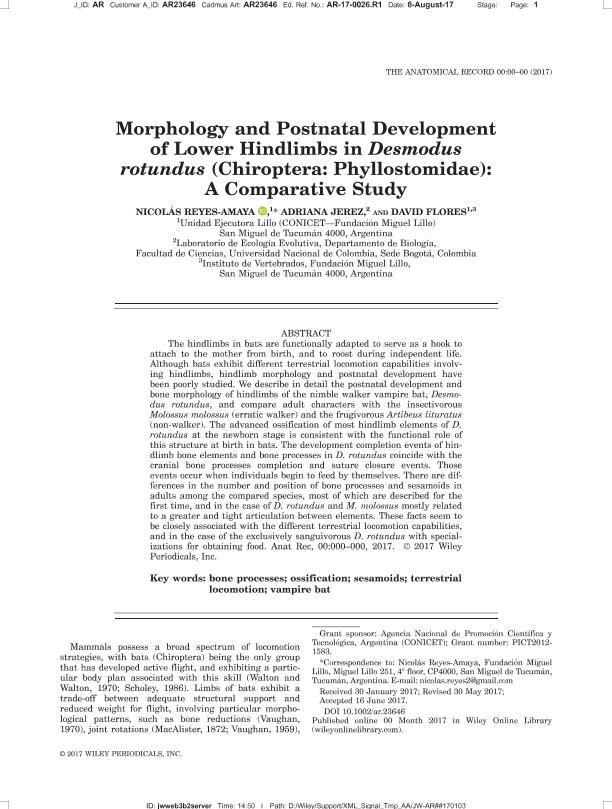Mostrar el registro sencillo del ítem
dc.contributor.author
Reyes Amaya, Nicolás Rafael

dc.contributor.author
Jerez, Adriana de Los Angeles

dc.contributor.author
Flores, David Alfredo

dc.date.available
2018-09-04T16:07:57Z
dc.date.issued
2017-12-14
dc.identifier.citation
Reyes Amaya, Nicolás Rafael; Jerez, Adriana de Los Angeles; Flores, David Alfredo; Morphology and Postnatal Development of Lower Hindlimbs in Desmodus rotundus (Chiroptera: Phyllostomidae): A Comparative Study; Wiley-liss, Div John Wiley & Sons Inc; Anatomical Record-Advances in Integrative Anatomy and Evolutionary Biology; 300; 12; 14-12-2017; 2150-2165
dc.identifier.issn
1932-8486
dc.identifier.uri
http://hdl.handle.net/11336/58240
dc.description.abstract
The hindlimbs in bats are functionally adapted to serve as a hook to attach to the mother from birth, and to roost during independent life. Although bats exhibit different terrestrial locomotion capabilities involving hindlimbs, hindlimb morphology and postnatal development have been poorly studied. We describe in detail the postnatal development and bone morphology of hindlimbs of the nimble walker vampire bat, Desmodus rotundus, and compare adult characters with the insectivorous Molossus molossus (erratic walker) and the frugivorous Artibeus lituratus (non-walker). The advanced ossification of most hindlimb elements of D. rotundus at the newborn stage is consistent with the functional role of this structure at birth in bats. The development completion events of hindlimb bone elements and bone processes in D. rotundus coincide with the cranial bone processes completion and suture closure events. Those events occur when individuals begin to feed by themselves. There are differences in the number and position of bone processes and sesamoids in adults among the compared species, most of which are described for the first time, and in the case of D. rotundus and M. molossus mostly related to a greater and tight articulation between elements. These facts seem to be closely associated with the different terrestrial locomotion capabilities, and in the case of the exclusively sanguivorous D. rotundus with specializations for obtaining food.
dc.format
application/pdf
dc.language.iso
eng
dc.publisher
Wiley-liss, Div John Wiley & Sons Inc

dc.rights
info:eu-repo/semantics/openAccess
dc.rights.uri
https://creativecommons.org/licenses/by-nc-sa/2.5/ar/
dc.subject
Bone Processes
dc.subject
Ossification
dc.subject
Sesamoids
dc.subject
Terrestrial Locomotion
dc.subject
Vampire Bat
dc.subject.classification
Otras Ciencias Biológicas

dc.subject.classification
Ciencias Biológicas

dc.subject.classification
CIENCIAS NATURALES Y EXACTAS

dc.title
Morphology and Postnatal Development of Lower Hindlimbs in Desmodus rotundus (Chiroptera: Phyllostomidae): A Comparative Study
dc.type
info:eu-repo/semantics/article
dc.type
info:ar-repo/semantics/artículo
dc.type
info:eu-repo/semantics/publishedVersion
dc.date.updated
2018-08-30T13:32:01Z
dc.journal.volume
300
dc.journal.number
12
dc.journal.pagination
2150-2165
dc.journal.pais
Estados Unidos

dc.journal.ciudad
Nueva York
dc.description.fil
Fil: Reyes Amaya, Nicolás Rafael. Consejo Nacional de Investigaciones Científicas y Técnicas. Centro Científico Tecnológico - Tucumán. Unidad Ejecutora Lillo; Argentina
dc.description.fil
Fil: Jerez, Adriana de Los Angeles. Universidad Nacional de Colombia; Colombia
dc.description.fil
Fil: Flores, David Alfredo. Consejo Nacional de Investigaciones Científicas y Técnicas. Centro Científico Tecnológico - Tucumán. Unidad Ejecutora Lillo; Argentina. Fundacion Miguel Lillo. Direccion de Zoologia. Instituto de Vertebrados; Argentina
dc.journal.title
Anatomical Record-Advances in Integrative Anatomy and Evolutionary Biology

dc.relation.alternativeid
info:eu-repo/semantics/altIdentifier/url/http://doi.wiley.com/10.1002/ar.23646
dc.relation.alternativeid
info:eu-repo/semantics/altIdentifier/doi/http://dx.doi.org/10.1002/ar.23646
Archivos asociados
